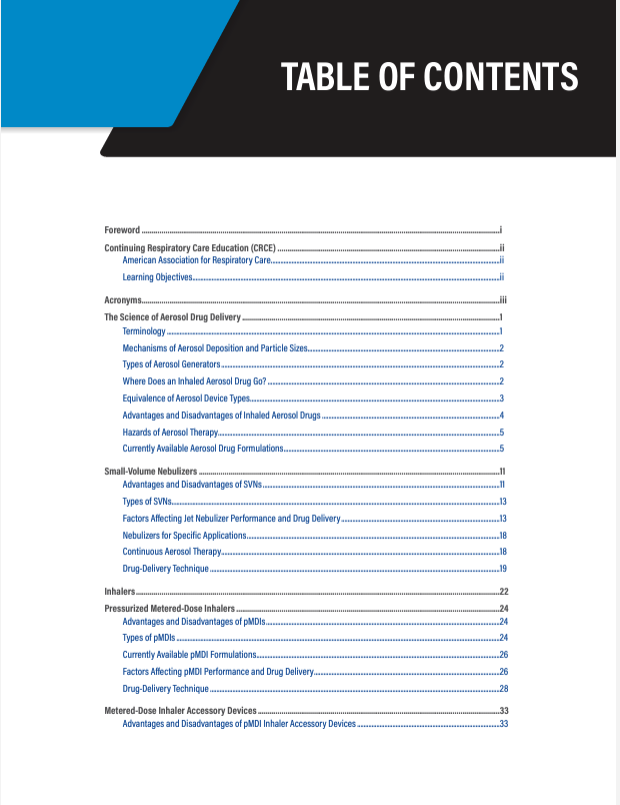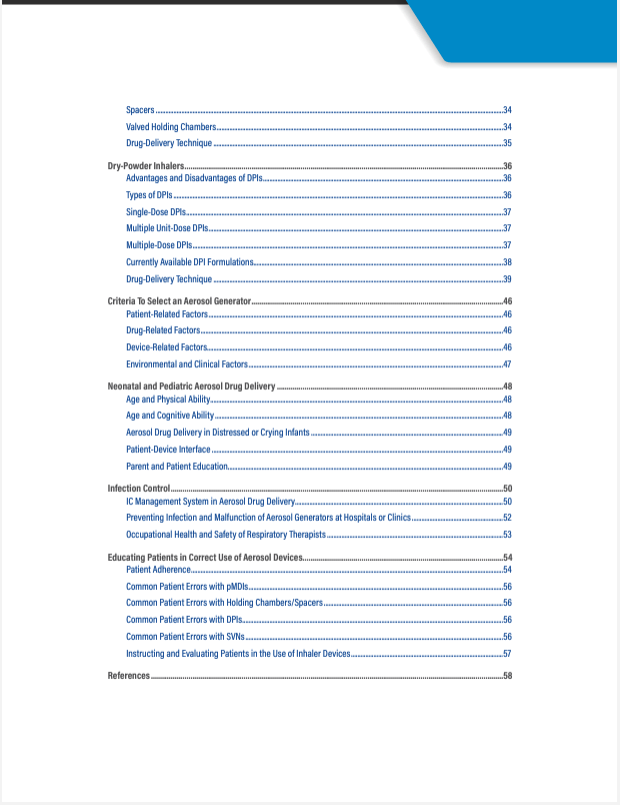About This Course
Aerosol therapy is a cornerstone of respiratory therapy that exemplifies the nuances of both the art and science of 21st-century medicine. As respiratory therapists are the only health care providers who receive extensive formal education and who are tested for competency in aerosol therapy, their ability to manage patients with both acute and chronic respiratory disease as experts in aerosol therapy allows the concept of “art” and “science” to take on a practical reality.
The fifth edition of this Aerosol Guide delivers detailed and comprehensive information that, when combined with your dedication and commitment to be the professional experts in this important area, will empower you to provide guidance to your physician, nurse, and pharmacist colleagues—but, most importantly, to your patients.
To access the post-course quiz, you must watch the entire intro video. The course content you will be tested on is available as a PDF in the Resources section or Materials tab.
AARC-University courses are reviewed and updated every 3 years to ensure the quality and relevance of your learning experience. You can only claim CRCE credit for a course once within its 3-year active period.
This course was developed in 2022 and is scheduled for a comprehensive review in 2025.
Sponsored by an unrestricted education grant from Monaghan Medical Corporation.

Learning Objectives
| List the advantages and disadvantages of inhalation compared to other routes of drug administration. | |
| Learn steps for the correct use of jet, ultrasonic, and mesh nebulizers. | |
| Compare and contrast the performance of pMDIs with HFA and CFC propellants. | |
| Identify the hazards of aerosol therapy that can impact the patient receiving therapy as well as care providers and bystanders. | |
| List the advantages and disadvantages of nebulizers for aerosol delivery. | |
| Describe the basic components of a metered-dose inhaler. | |
| Compare and contrast the design of holding chambers and spacers. | |
| Discuss factors affecting pMDI performance and drug delivery. | |
| List the advantages and disadvantages of metered-dose inhalers. | |
| Compare the principles of operation of a jet nebulizer, a mesh nebulizer, and an ultrasonic nebulizer. | |
| Describe the types of pneumatic jet nebulizer designs and methods that are used to decrease aerosol loss from a jet nebulizer during exhalation. | |
| Explain the importance of priming and tracking the number of doses for a metered-dose inhaler. | |
| List the correct steps for use of a nebulizer, inhaler, metered-dose inhaler with holding chamber or spacer, and dry-powder inhaler. | |
| State the approximate amount of aerosol deposited in the lower respiratory tract for nebulizers, pressurized metered-dose inhalers (pMDIs), and dry-powder inhalers (DPIs). | |
| Identify factors that affect dose delivery from a holding chamber or spacer. | |
| Describe the principles of operation of various commercially available dry powder inhalers. | |
| Discuss criteria to assist clinicians in selecting an aerosol delivery device. | |
| Explain how you know that each DPI is empty. | |
| Identify special considerations for neonatal and pediatric drug delivery. | |
| Describe how to instruct and evaluate patients on the use of inhaler devices. | |
| Discuss the importance of occupational health and safety for respiratory therapists. | |
| Explain how to establish an infection control management system for aerosol drug delivery. | |
| List the advantages and disadvantages of dry-powder inhalers. | |
| Describe the proper technique for cleaning aerosol delivery devices. | |
| Describe the causes and solutions of problems seen with nebulizers, pMDIs, and DPIs. | |
| Identify factors affecting DPI performance and drug delivery. | |
| List common problems and errors with each type of inhaler. | |
| Identify the terminology used in aerosol medicine. |
Chapters


Authors
| Douglas Gardenhire | EdD, RRT, RRT-NPS, FAARC | ||
| Linda Nozart | MPH, RRT, AE-C | ||
| Sandra Hinski | PhD, RRT, RRT-NPS |




